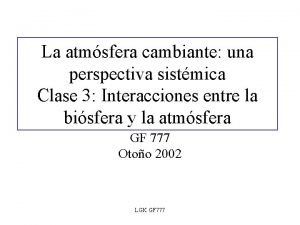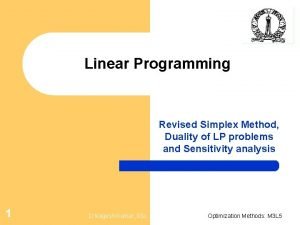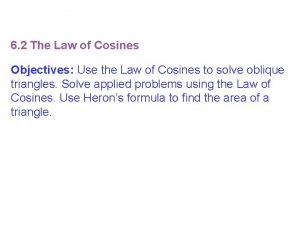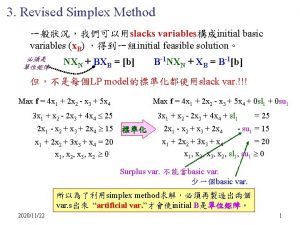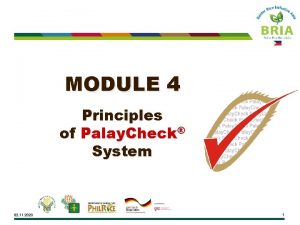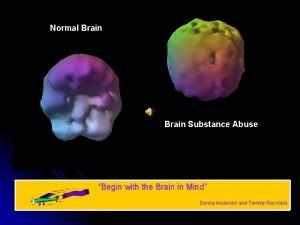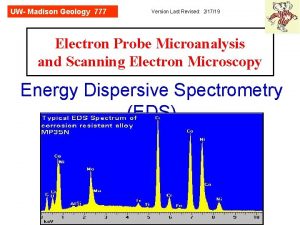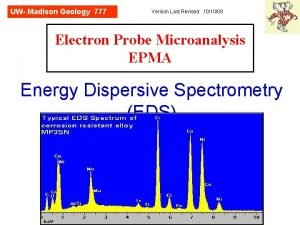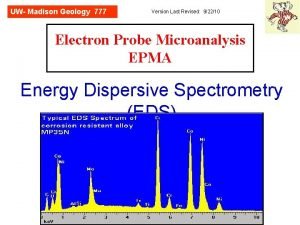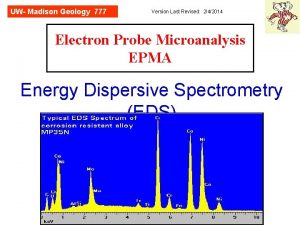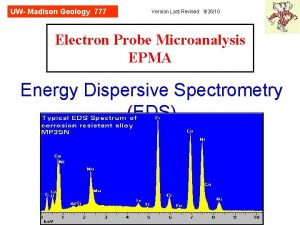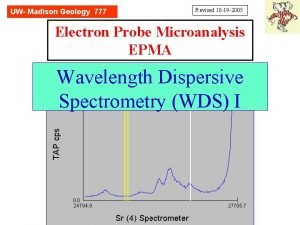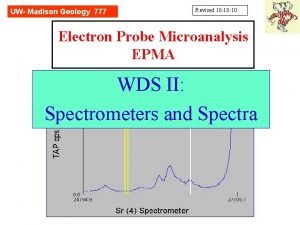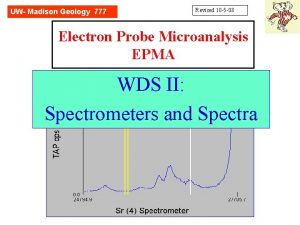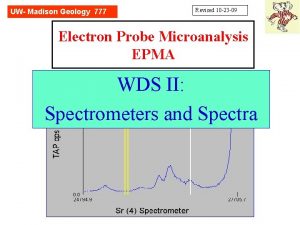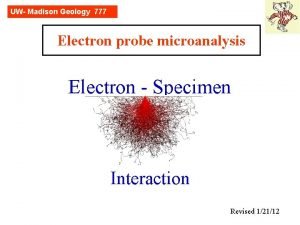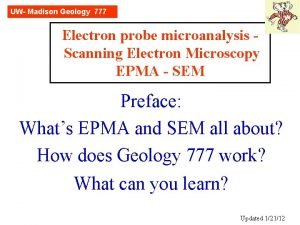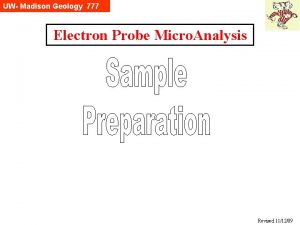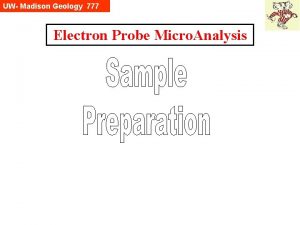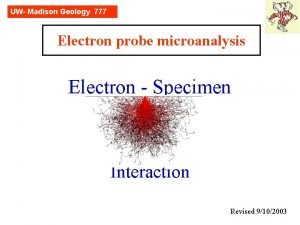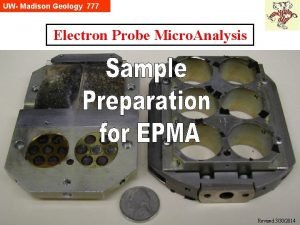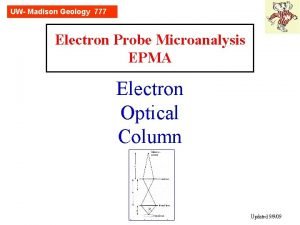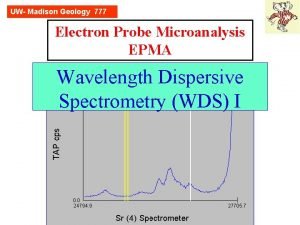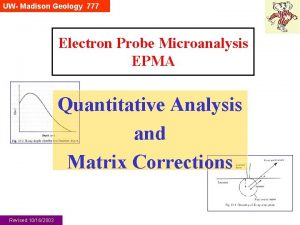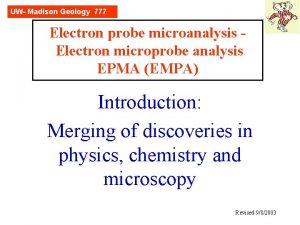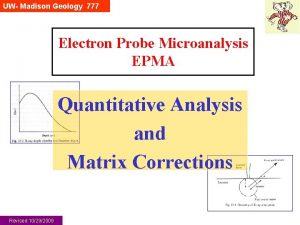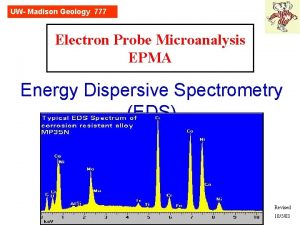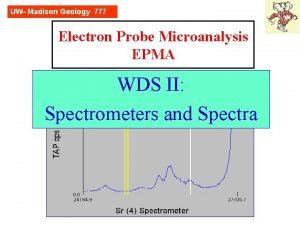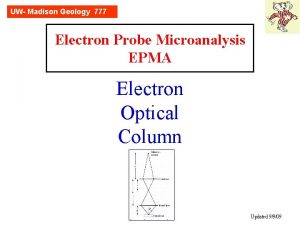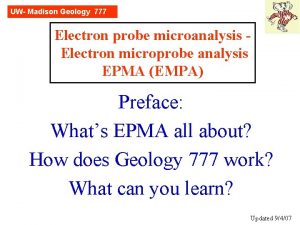UW Madison Geology 777 Version Last Revised 21719





























































- Slides: 61

UW- Madison Geology 777 Version Last Revised: 2/17/19 Electron Probe Microanalysis and Scanning Electron Microscopy Energy Dispersive Spectrometry (EDS)

UW- Madison Geology 777 What’s the point? -> Fast way to see what essential chemistry is of a small region of a sample. -> Using X-rays to produce ehole pairs (charges proportional to X-ray intensity), which are amplified and then “digitized”, put in a histogram of number of X-rays counts (y axis) versus energy (x axis). EDS spectrum for NIST glass K 309 (Goldstein et al, Fig. 6. 12, p. 356) -> A solid state technique with unique artifacts. Very powerful but can (easily) produce incorrect results if treated as a “black box”. (Thus, a reason to take this class!)

UW- Madison Geology 777 1… 2… 3… 4… 5’s of EDS • Technology relatively simple • Rapid peak ID, qualitative, • Can treat as a “black box” - • But beware of “gotchas”! • Can be semi-quantitative (‘standardless’) • But optimally want to be ‘truly’ quantitative, but takes extra care and procedures (“QC”)

UW- Madison Geology 777 Technology Update: 1970 s-2000 s Si. Li detector needed LN*; Count rates limited to 10’s of thousands *LN=Liquid Nitrogen >20002019… SDD needs minimal cooling—NO LN!; uses Peltier cooler; Count rates in 100 s of thousands; other advancements

UW- Madison Geology 777 Overall basics of operation are the same Si. Li detector needed LN; Count rates limited to 10’s of thousands SDD needs minimal cooling—NO LN!; uses Peltier cooler; Count rates in 100 s of thousands; other advancements

UW- Madison Geology 777 3 Initial EDS Facts • X-rays cause small electric pulses in a solid state detector by process of “photoelectric absorption” (process discovered by Einstein, shining light on a metal and seeing electrical current) • . Associated electronics produce ‘instantaneously’ an X -ray spectrum, i. e. a histogram of counts (number=intensity) vs the energy of the X-rays • Critical to understand recognize artifacts* *Artifact = something observed in a scientific investigation or experiment that is not naturally present but occurs as a result of the preparative or investigative procedure.

How it works: energy gap A semi-conductor like Si has a fully occupied valence band largely unfilled conduction band, separated by an energy gap (1. 1 e. V). Incident energy can raise electrons from the valence to the conduction band. X-ray hits the Si. Li crystal, producing a specific number of electron-hole pairs proportional to X-ray energy; e. g. one pair for every 3. 8* e. V, so for incident Fe Ka, 6404 e. V, 1685 e-hole pairs are produced. With a bias** applied across the crystal, the holes are swept to one side, the electrons to the other, producing a weak charge. Boron is important acceptor impurity in Si and degrades it (permits thermal excitation: bad); at the factory, Li is drifted in (donor impurity) to counter its effects. * 1. 1 e. V + energy wasted in lattice vibrations, etc **bias: a voltage is applied between 2 points; e. g. one +1500 v, other -1500 v. Goldstein et al, 1992, Fig 5. 19

UW- Madison Geology 777 How it works: inside the detector X-rays are absorbed by Si, with photoelectrons ejected. This photoelectron then creates electronhole pairs as it scatters inelastically. The Si atom is unstable and will either emit a characteristic Auger electron or Si ka X-ray. If Auger, it scatters inelastically and produces electron-hole pairs. If Si Ka X-ray, it can be reabsorbed, in a similar process, or it can be scattered inelastically. In either case, the energy will end up as electron-hole pairs. The result, in sum, is the conversion of all the X-ray’s energy into electron-hole pairs – with several critical exceptions. Fig 9. 5 Reed; Fig 5. 22 Goldstein

UW- Madison Geology 777 Artifact #1: Si-escape peak; There are 3 exceptions to the neat explanation of how the Si(Li) detector works. Si-escape peaks are artifacts that occur in a small % of cases, where the Si ka X-ray generated in the capture of the original X-ray escapes out of the detector (red in figure). Since this X-ray removes 1. 74 ke. V of energy, the signal generated (electron-hole pairs) by the incident X-ray will be 1. 74 ke. V LOW. This will produce a small peak on the EDS spectrum 1. 74 ke. V below the characteristic X-ray peak. Fig 5. 22 Goldstein et al

UW- Madison Geology 777 Fig 16. 4 Goldstein et al, 2018 Artifact #1: Si-escape peak; You can be fooled because this energy may be that of an X-ray of some element!

UW- Madison Geology 777 Artifact #2 Si internal fluorescence peak; The figure shows a real spectrum of a sample of pure Ti metal -- but there are several peaks besides the Ti Ka and Kb. As discussed in the previous slides, at 1. 74 ke. V below each, are the respective escape peaks (blue arrows). There is also a finite probability that the “dead Silicon layer” can be excited and a real Si Ka X-ray generated. This is called the Si internal fluorescence peak (green arrow). For this reason, it is impossible to measure low abundances of Si in samples and be certain they are from the sample and not an instrumental artifact. Goldstein et al Fig 5. 39, p. 316

UW- Madison Geology 777 Artifact 2 Note: This is a spectrum of copper metal. There is no Si, no O, no C, inside the Copper. . . so why the other peaks? ! Si internal fluorescence peak

UW- Madison Geology 777 Artifact #3 Sum (‘coincidence”) peaks There is a finite probability that two Xrays may enter the detector (almost) simultaneously and if too close in time, the pulse processing system will mistake them for ONE X-ray. This occurs for the highest concentration elements (it’s all probabilities). Here, we see small sum peaks, where 2 Ti Ka X-rays arrived together, and a smaller one where a Ti Ka and at Ti arrived together). • Newer systems attempt to remove them before they go into a quant analysis and add them back to proper element, • Older systems can’t do that (or not well) Note the scale of the spectrum: the Ti Ka max is 1. 3 million counts. These effects are generally weak, but evident when you are looking for minor elements. Goldstein et al Fig 5. 39, p. 316

UW- Madison Geology 777 Artifact #3 Sum (‘coincidence”) peaks Goldstein et al, 2018, Fig 16. 4

UW- Madison Geology 777 Critical Artifacts: Sum Peaks There is a short period of time (t 0) during each X-ray capture by the EDS detector, when the detector can capture a second X-ray “by mistake”. The electronics cannot distinguish this “sum peak” from a true single X-ray peak, and includes it with all the other peaks from the elements actually present. For 2 major elements, could be 3 sum peaks; for 3, 6. In reality, you only see 1 or 2 unless you zoom in to the background level. Always consider their possible presence.

UW- Madison Geology 777 …Fools even the pros Even the fanciest, slickest EDS setup can fool newcomers, not to mention experienced users. Above, is a partial spectrum (major peaks) of a commercial glass that has a lot of Si and O, plus Na and Al. Notice the S (Sulfur) label over a peak around 2. 3 ke. V … sure looks like it might be Sulfur, right? It is NOT, rather it is a sum peak of O Ka (. 525 ke. V)+ Si Ka (1. 74 ke. V). Previous experience with this “fake” peak had taught me to be skeptical

UW- Madison Geology 777 Sum Peaks In qualitative analysis of silicates, there are some combinations of element Ka peaks that fall close to Ka peaks of elements possibly present, as indicated in the table below: Some of more advanced EDS software now contain algorithms to recognize and automatically remove sum peaks. But you must always be on guard for them, particularly ones which “could really be there”. In many of those cases, WDS is the solution.

UW- Madison Geology 777 Artifact #4 Extraneous peaks One of the benefits of the EDS detector is that it is mounted inside the chamber, just inches from the specimen. We say it has a large solid angle. On older systems where there may not have been “protection”, that is, collimation, to prevent extraneous Xrays, there could be found extraneous X-rays. The Fe and Cu peaks are from excitation of metal in chamber or sample holder by BSE or Ti X-rays. Note the scale of the spectrum: the Ti Ka max is 1. 3 million counts. These effects are generally weak, but evident when you are looking for minor elements. Goldstein et al Fig 5. 39, p. 316

UW- Madison Geology 777 Extraneous Coating Artifacts Another thing: many SEM labs use gold or palladium coating on specimens. These very thin coats will produce definite x-ray peaks! Family of Pd L lines

UW- Madison Geology 777 Artifact #5 Absorption Edge Dropoff The figure shows a real spectrum of a sample of pure Ti metal -- but there are 7 peaks besides the Ti Ka and Kb. Note the sharp drop in the background intensity on the high side of the Ti Kb peak (= Ti K absorption edge, red arrow). This means that the background (continuum) is lower than it should be, as those continuum X-rays –above the Ti K edge – are “recycled” to excite MORE the Ti Ka and Kb Xrays. Note the scale of the spectrum: the Ti Ka max is 1. 3 million counts. These effects are generally weak, but evident when you are looking for minor elements. Goldstein et al Fig 5. 39, p. 316

UW- Madison Geology 777 Detection of X-ray: Si. Li vs SDD Si. Li=Silicon Lithium Drifted Detector (older) SDD=Silicon Drift Detector (newest) Goldstein et al, 2018, SEMXRMA, p. 211

UW- Madison Geology 777 Silicon Drift Detector The SDD is similar to Si. Li Detector in that electron-hole pairs are generated, but the physical design is radically different. There is a lower capacitance, and also a lower leakage current (high leakage current in Si. Li is what requires LN cooling). And because the SDD has the FET “built in”, created during the lithography of the Si crystal, wires are eliminated, reducing capacitance more. Resulting advantages: 1. LN not needed (use a simple Peltier cooler) 2. Can handle high count rates >100, 000 up to ~106 cps 3. Spectral resolution at 100, 000 cps still good (~140 -150 e. V)

Image from Bruker web page The SDD is created from a single Si crystal using micro-lithography. “The major distinguishing feature of an SDD is the transversal field generated by a series of ring electrodes that causes charge carriers to 'drift' to a small collection electrode. The 'drift' concept of the SDD (which was imported from particle physics) allows significantly higher count rates. ” - Wikipedia

UW- Madison Geology 777 Detection of X-ray: SDD Silicon Drift Detector Goldstein et al, 2018, SEMXRMA, p. 211

UW- Madison Geology 777 Overall basics of both EDS types (Si. Li, SDD) are similar A somewhat simplified setup is: • • A window separating the sample chamber from the detector; The detector in its own vacuum; The detector itself--today mainly SDD, but also Si. Li and Ge (e. g. on Weeks Powder X-ray Diffraction System); A cooling system (LN or Peltier cooler); The FET (field effect transistor converts pulse to voltage); Pre-amp (power to FET, and initial amplification); Pulse processor; Software for further processing and display

UW- Madison Geology 777 Focus on the modern EDS A description here of features BEFORE the crystal: • • • A collimator (1) to minimize X-rays NOT coming from the beam landing spot on the sample (i. e. stray ones from sample holder or chamber wall, from backscattering); An electron trap, 2 permanent magnets (2) to deflect stray electrons, which would cause problems; only needed for thin polymer windows; thicker Be windows stop electrons <20 ke. V; A window (3), today mainly a thin polymer one which will allow energy (to ~100 e. V) X-rays to pass. Metal ribbing. Figure from Oxford Instruments

UW- Madison Geology 777 Focus on the modern EDS A description here of features from the crystal on: • • • The crystal (4) in the past was mainly a Si. Li (silicon drifted with lithium to compensate for inpurities. Today all sold are SDD, silicon drift detectors. It is a semiconductor in which each incident X-ray causes generation of an electric charge –a discrete number of “electron -hole pairs” proportional to the X-ray energy This electric charge is converted into a voltage in the FET (5), field effect transistor. This is all cooled (Peltier cooler). Figure from Oxford Instruments

UW- Madison Geology 777 EDS Windows allow X-rays to pass and protect detector from oil/ice and light (Be). Be: The most common EDS detector window was Be foil ~7. 6 mm (0. 3 mil) thick. It allows transmission of X-rays above ~ 1 ke. V (poor for Na!) It is strong enough to withstand venting to atmospheric pressure, and opaque to optical photons. Thin - Ultrathin: For transmission of light element X-rays (<1 ke. V), windows ~0. 25 mm thick of BN, Si. N, diamond or polymer are used. They must use supporting grids to withstand pressure differentials; the grid (e. g. , Si or Ni) takes up about 15% of the area, but the window material is thin enough that low energy X-rays pass through. (e. g. , SATW: super atmospheric TW) This plots shows the transmittance of X-rays thru different types of window material. (Quantum [BN] 0. 25 um, diamond 0. 4 um). The higher the transmission number, the better “Windowless”: Here there is no film, and there is a turret that allows swapping with a Be window. Difficult to use as oil or ice can coat the detector surface. Not used much. Goldstein Fig. 5. 41, p. 318

UW- Madison Geology 777 X-ray Transmission through EDS Windows This plots shows the transmittance of X-rays thru different types of window material. (Quantum [BN] 0. 25 um, diamond 0. 4 um). The higher the transmission Goldstein Fig. 5. 41, p. 318 number, the better.

UW- Madison Geology 777 Question: Do all characteristic X-rays have Si-escape peaks in a Si(Li)/SDD detector? Why or Why Not? Hint 1: Sr La does not, but Os Ma does Hint 2: Look up the characteristic energies of each Hint 3: Look up the absorption edge (critical excitation) energy of Si Ka Hint 4: Compare the numbers in 2 to number in 3. Which one is greater than the one in #3? Would a Si Ka x-ray produced in the sample, which then makes its way thru the vacuum to the EDS detector, have enough energy to knock out the inner shell (K) electron of the Si detector crystal?

UW- Madison Geology 777 Detector performance: peak resolution (FWHM) The characteristic X-rays generated in the specimens are very close to lines, i. e. only a few e. V wide at most. However, the conversion of X-ray to a pulse in the detector has several variables (imperfections) that broaden the Mn Ka peak to between 125 -200 e. V, depending upon the type of detector and how well maintained it is. The narrowness of the peak is measured by the width of the peak at one half the maximum intensity of the peak -- this is what is termed the FWHM. In EDS detectors, it is usually measured at the Mn Ka position, with values of 160 e. V and below. Modern (2005) one are quoted at <130 e. V. Goldstein et al, Fig 5. 34, p. 311

UW- Madison Geology 777 Why Mn Ka for EDS resolution? EDS companies (their engineers mainly) do not want to have to carry around an SEM or EMP to be able to test, repair and calibrate an EDS system. Instead they carry a small 1” diameter x 2” long tube that fits over the end of the EDS “snout”. Inside it is an Fe-55 isotope source (half life 2. 7 yr) which emits an intense x-ray at 5. 985 ke. V which is only a few e. V different than Mn Ka.

UW- Madison Geology 777 Old school “nim bin” processing Signal processing Si(Li) detector has no internal gain*; for Ca Ka photon with ~1000 e-hole pairs, the charge is only ~10 -16 Coulomb (weak!) Directly coupled to the Si crystal is a field effect transistor (FET) that converts charge to voltage, followed by a preamp. We need low noise, high gain amplification, so the Si. Li detector and FET are cooled to about 100 K with liquid nitrogen (LN) to prevent noise (and prevent diffusion of Li in detectors). More signal gain provided by main amplifier (signal now boosted to 1 -10 volts) where also RC (resistor-capacitor) circuits are used to shape the pulse, to maximize signal/noise ratio and minimize pulse overlap at high count rates. Then ADC (analog to digital converter) outputs data to the screen as a spectrum display. *gain = electronic multiplication of signal intensity

UW- Madison Geology 777 The first signals in the EDS detector The set of electron-hole pairs produced by the impact of the X-ray on the Si(Li) detector produces a tiny charge (~10 -16 C), very quickly (~150 x 10 -9 sec). The FET(preamplifier) changes the charge (capacitance) into a tiny voltage (millivolts). These steps are shown in the first half of (a) to the right. The output of the FET is shown below at (b) where the x axis is time and y is voltage. The “jump” represents the presence of a voltage proportional to the number of electron-hole pairs generated by each X-ray, so Photon 2’s jump is of a higher energy than Photon 1’s jump which is higher than Photon 3’s jump. At a certain point the FET reaches the limit of the number of “ramp” charges it can hold, and then there is a reset or zeroing back to some baseline where it starts over. Following this are electronics to shape the voltage into a pulse that can be counted. Goldstein et al (1992), p. 297

UW- Madison Geology 777 Processing Time and Pulse Pileup Rejection The user can ‘tweak’ the time constant (T. C. ) which sets the time allocated in the electronics to process each pulse (=X-ray). In the top figure, a short T. C. (1 ms) permits each pulse to be counted correctly. A longer T. C. (10 ms) means the “gate” is open longer and a second pulse can enter and be incorrectly added; this is “pileup” and causes distorted spectra. Therefore, circuits are added (#4, bottom figure) to sense when pileup occurs and to ignore that pulse. Goldstein et al (1992), Fig. 5. 24 and 5. 25, p. 300

UW- Madison Geology 777 Dead Time: Si. Li “Deadtime” is the period during which the detector is “busy” and cannot accept/process pulses. This can introduce error unless it is accounted for, either by extending counting time, or correcting for it in the software. In most systems, the user sets the “live time” which is the time during which counts are actually counted, and the “real time” is automatically determined by the electronics or software. Optimal deadtime is in the 35 -45% range. This optimizes both user/machine time and moderate to high throughput of counts. 40% 60% e im i t d 80% a De Above: an old Si. Li system Lowest curve: long shaping constant of 100 us yields a max of 8000 cps for sharpest peak (142 ev fwhm) Highest curve: short shape constant of 20 us yields ~35, 000 cps but peak degraded to 190 e. V fwhm. Mapping. Goldstein et al (2003), Fig. 7. 9 (p. 307)

UW- Madison Geology 777 Dead Time: SDD’s have much higher thru -put; the physical structure reduces capacitance degradition effects, allowing very fast pulse shaping time (=amplified time constant) On our Oxford AZTec EDS, this is known as “time constant”, 1 -6. “Normal operation is at “ 3”. For X-ray mapping 1 - would be used, and for best/tightest peaks, 6 would be used. HOWEVER the operator must change the current settings for these (much lower for 1, higher for 1). Above: “futuristic system”. ICR: Input Count Rate (perfect detector, 100% of counts detected (“output”) OCR: Output Count Rate With 4 SDDs working together, you can get 550, 000 counts/sec out with good spectral resolution (127. 5 e. V@Mn. Ka), at deadtime of ~66% Goldstein et al, 2018, SEMXRMA, p. 217

UW- Madison Geology 777 Too Much Dead Time? ? We’ve shown that at a certain deadtime, it makes NO sense to increase the count rate, as the output “falls over” (decrease). In the SDD case, the figure shows that you can crank up your current and not get decreased counts up to ~66% DT. But should you do that? ? ? The other aspect, not shown here, is the length of real (clock) time that this can take. At 66% DT, it will take 300 seconds to acquire 100 seconds of counts. At 50% DT, it will take 200 seconds. At 33% DT it will take 150 seconds. Above: “futuristic system” ICR: Input Count Rate (perfect detector, 100% of counts detected (“output”) OCR: Output Count Rate With 4 SDDs working together, you can get 550, 000 counts/sec out with good spectral resolution (127. 5 e. V@Mn. Ka), at deadtime of ~66% DT(%) = [(ICR-OCR)/ICR] x 100% Goldstein et al, 2018, SEMXRMA, p. 217

UW- Madison Geology 777 Time Constant*+Beam Current--> Dead Time Current TC DT Cts Res Comment Low Short 10% 2000 150 e. V Takes a long time to get a decent spectrum Low Long 20 -30% 1000 135 e. V Optimal for phase ID High Short 40 -60% 10 -20 K 180 e. V Optimal for X-ray mapping High Long 100% Good for nothing 0 ___ The above values are based upon older Si. Li detector, are approximate, and meant only to show the relation of the variables. Similar trends hold for SDD. * = Process Time in Oxford AZtec

UW- Madison Geology 777 Time Constant = Process Time in Oxford AZtec Process. SDD Time “ 1” 1 microsecond Process Time “ 2” 2 microseconds Process Time “ 3” 3 microseconds Process Time “ 4” 4 microseconds Process Time “ 5” 7 microseconds Process Time “ 6” 16 microseconds (These values hold for our specific Oxford AZtec SDD and may differ on other instruments) The “normal generic” setting is 4, but certainly can and should be changed if needed.

UW- Madison Geology 777 Spectral processing: background correction The characteristic X-rays that we need to quantify “ride” atop the continuum, and the continuum contribution to the characteristic counts must be subtracted. (Top) Linear interpolation (B-D) will be in error due to the abrupt drop of continuum at the Cr K-absorption edge (5. 989 ke. V). B-C is possible but critically dependent upon having good spectral resolution (<160 e. V). A-B would be preferable. (Below) Doing background fit of a complex stainless steel. Goldstein et al Fig. 7. 1, 2, p. 367

UW- Madison Geology 777 Spectral processing: background modeling or filtering Correcting for the background is done by either of 2 methods: developing a physical model for the continuum, or using signal/noise filtering. Modeling is based upon Kramers Law: there is a function describing the continuum at each energy level, that is a function of mean atomic number, and measured “detector response”.

UW- Madison Geology 777 Background Modeling The spectrum of Kakanui hornblende (top left), with superimposed calculated (modeled) background, based upon Kramers Law*. Bottom figure shows after the background has been subtracted. Cu is artifact (stray X-rays). Mn is actually present at <700 ppm. Ij = constant x Z (E 0 - Ej) / Ej at each energy channel j Goldstein et al Fig 7. 4, p. 372

UW- Madison Geology 777 Background Filtering Theoretically Fourier analysis will separate out the low frequency continuum signal and high frequency ‘noise’ from the medium frequency characteristic peaks; however, there is overlap and the result is a poor fit. A better filter is the “top hat filter”, where no assumptions are made about the spectrum, and only the mathematical aspects of signal vs noise are considered.

UW- Madison Geology 777 Top Hat Filtering This filter (top right) moves across the EDS spectrum (with an optimally defined window, ~ 2 FWHM* Mn Ka; ~320 e. V), and assigns a new value for the center channel based upon subtracting the values in the left and right channel from the center (value hk chosen to total area =0). Thus, in the simple spectrum (bottom right), the center channel (+), when the left and right channels are subtracted, leaves a value ~0. *FWHM: full width at half maximum. Reed Fig 12. 7 p. 174, Goldstein et al Fig 7. 6, p. 374

UW- Madison Geology 777 …And beware of lazy peak IDs Even the fanciest, slickest EDS setup can make misidentifications…so the analyst cannot get lazy and assume just because the expensive software said something was there, it was there. I knew Arsenic was possible (As La identified), but unlikely, and rather Mg Ka was more likely. To confirm it was NOT As, I cranked the accelerating voltage up to 20 ke. V (the K shell binding energy is 11. 9 ke. V) and found there was NO As Ka x-ray. Ergo, not As.

UW- Madison Geology 777 …and trusting software As Newbury (2005 and 2006 reply) pointed out, an EDS operator is a fool to believe that the automatic peak ID will be correct 99. 9% of the time. From Newbury (2006)

UW- Madison Geology 777 Artifical EDS spectrum Artificial: no background, no artifacts, and assumes EACH element at 100% concentration. Why, then, the two slopes? ? Peak intensities of elements from Si to Na decrease, and also from Si to Zn -- why? (Hint: 2 physical phenomena)

UW- Madison Geology 777 Artificial spectrum The actual spectrum of pure elements, as generated at the point of impact, would be one steady decreasing curve from Na down to Zn, following the red curve superimposed here. Slope down from Si to Na: Xray energies are increasingly weaker, and are absorbed both within the specimen and by the window. Slope down from Si to Zn: there are less and less X-rays being produced because the accelerating voltage is constant (e. g. 20 ke. V) and the overvoltage is lower.

UW- Madison Geology 777 Evolution of EDS spectrum: from the specimen to the monitor - 1 Simulation of element (say V) X-ray generation and display The spectrum on our monitor (d) is a result of many things impacting the real spectrum generated within the specimen (a). At instant of generation within the specimen, there is only the Ka, Kb and continuum. An instant later (b), as the Xrays leave the specimen, two things can happen: some of the continuum X-rays above 5. 464 ke. V are absorbed, producing the drop in the continuum there. Goldstein et al Fig 5. 53 (by R. Bolon) p. 330

UW- Madison Geology 777 Evolution of EDS spectrum: from the specimen to the monitor - 2 Also in (b) the lower energy continuum is absorbed, causing the dropoff in the spectrum there. When the X-rays hit the detector (c), Si fluorescence peaks can result. And after signal processing (d), the display will show peak broadening, sum peaks, Si-escape peaks, further decrease of intensity and low energy noise. Simulation of element (say V) X-ray generation and display Goldstein et al Fig 5. 53 (by R. Bolon) p. 330

UW- Madison Geology 777 Practical considerations • Select proper time constant • Select proper beam current for • Goldstein et al 2018 (p. 217) suggest 5 e. V wide channels, so for 0 -20 ke. V, 4096 channels would be used. There is a short period of time (t 0) during each X-ray capture by the EDS detector, when the detector can capture a second X-ray “by mistake”. The electronics cannot distinguish this “sum peak” from a true single X-ray peak, and includes it with all the other peaks from the elements actually present. For 2 major elements, could be 3 sum peaks; for 3, 6. In reality, you only see 1 or 2 unless you zoom in to the background level. Always consider their possible presence.

UW- Madison Geology 777 EDS-WDS comparison

UW- Madison Geology 777 Recent Developments Over the past 15 -20 years, 2 new “spins” off the ‘old school’ Si(Li) EDS detector have entered the microanalysis world: 1. The Silicon Drift Detector made it to big time. 2. The microcalorimeter not yet there… 3. WDS on SEM: collimated etc

UW- Madison Geology 777 Microcalorimeter The principal behind the microcalorimeter is that an x-ray hitting a very sensitive thermal absorber will register a very small temperature increase. However, this requires a very cold absorber, with liquid helium cooling required. It would provide the best of both EDS and WDS, with simultaneous capture of all x-ray energies AND with very tight spectral resolution (like with WDS). However, there apparently have been major engineering stumbling blocks and none have made it to the market.

UW- Madison Geology 777 Further EDS details There are several modern EDS companies, with most producing very informative brochures that go into the technical details of EDS hardware (and software): For example: Oxford Instruments http: //www. oxfordinstruments. com/products/microanalysis/energydispersive-x-ray-systems-edx/eds-for-sem/sdd has a nice technical publication explaining EDS using the SDD as the detector. Well worth downloading and reading. url updated 2/4/14

UW- Madison Geology 777 Comments about LN 2 and EDS That big tank of liquid nitrogen cools the Si. Li crystal and the FET, so the very low charge generated by the electrons-holes can be detected with minimal noise. But what about letting the thing warm up when you’re on vacation? There is a lot of misunderstanding about this… Modern systems “can” be allowed to warm up without damage to the crystal (if the bias on it is turned off), but the Li can drift out, so best to keep it LN cold. There’s another important consideration: the vacuum within the snout that extends from the bottom of the dewar to the end where the detector sits -- there is a “getter” (zeolites or Al wool) inside that absorb yucky contaminants. But if the getter warms up, they are released inside the snout, creating a poor vacuum, which then means the LN usage increases significantly as the vacuum is poor. Bottom line: keep it cold all the time.

EDS at Low Voltages In many cases, you are not just collecting images, but using EDS to qualitatively determine the composition of some phase in your sample. Operating at 15 or 20 k. V gives access to K lines of elements from B to ~Se, to L lines of elements from Fe to ~Au or Pb, and M lines of most of the rest of the periodic table. However, operating at say 5 k. V reduces the lines that are available for EDS examination -- and they are all crunched together, with potentially many interferences and non-unique interpretations.

Interferences at Low Voltages From Newberry 2002 Figure 6 As Newberry (2002) points out, EDS operation at low k. V is fraught with difficulties, as demonstrated in his figure. If oxygen and/or carbon are present (either intentionally or not!), there are many important L and M lines that are

Additionally, as the surface layers become more important (that’s the region the electrons are paying more attention to), then little details like oxide skins (most metals will form some oxide layer, even gold, according to one report I’ve seen). Therefore, a single low voltage EDS spectrum can be a convolution of both the deeper material composition plus the surface skin contribution -which makes for non-unique solutions to the question: is there trace amounts of oxygen present in this metal?

UW- Madison Geology 777 Summary • X-rays cause small electric pulses in a solid state detector by process of “photoelectric absorption” • . Associated electronics produce ‘instantaneously’ a spectrum, i. e. a histogram of counts (number=intensity) vs the energy of the X-ray • Relatively inexpensive; there are probably 50 -100 EDS detectors in the world for every 1 WDS (electron microprobe) • Operator should be aware of the limitations of EDS -specific spectral artifacts, poor spectral resolution for some pairs of elements, and usual lack of quality control of results (beware of perfect “ 100 %” results!)
 A revised version of little red riding hood
A revised version of little red riding hood Crc boeing 777
Crc boeing 777 P 777
P 777 Oceanic airlines 747
Oceanic airlines 747 777.nine99
777.nine99 Onlyblue00
Onlyblue00 Code in hospital
Code in hospital Pinpoint simulations 777
Pinpoint simulations 777 777 indiana avenue
777 indiana avenue 777
777 Concurrent engineering disadvantages
Concurrent engineering disadvantages 1553 bus vulnerabilities
1553 bus vulnerabilities Fração geratriz de 0 777
Fração geratriz de 0 777 National revised teaching plans grade 10
National revised teaching plans grade 10 Bvmtr
Bvmtr Csc form no. 33-a revised 2018
Csc form no. 33-a revised 2018 Revised trauma score
Revised trauma score 2020 revised curriculum and assessment plans
2020 revised curriculum and assessment plans Ohio revised code towing regulations
Ohio revised code towing regulations Qprofits
Qprofits Vision and mission of gauteng department of education
Vision and mission of gauteng department of education Besliskunde matrix
Besliskunde matrix Revised path goal theory
Revised path goal theory Revised curriculum 2020
Revised curriculum 2020 2021 revised curriculum and assessment plans
2021 revised curriculum and assessment plans Early childhood screening rochester mn
Early childhood screening rochester mn 2020 revised curriculum and assessment plans grade 7
2020 revised curriculum and assessment plans grade 7 Grade 6 geography term 1 test
Grade 6 geography term 1 test Revised bp form 202
Revised bp form 202 Revised curriculum 2020
Revised curriculum 2020 Revised dual simplex method
Revised dual simplex method 2020 revised curriculum and assessment plans
2020 revised curriculum and assessment plans Sbm tools
Sbm tools Peabody individual achievement test manual
Peabody individual achievement test manual Ems grade 8 term 1 assignment
Ems grade 8 term 1 assignment Unit 6 revised solving oblique triangles
Unit 6 revised solving oblique triangles Asl napoli 1c
Asl napoli 1c Simplex method教學
Simplex method教學 2020 revised curriculum and assessment plans
2020 revised curriculum and assessment plans Otes2.0
Otes2.0 Palaycheck system key check
Palaycheck system key check Revised primary curriculum grade 1-3
Revised primary curriculum grade 1-3 Category i cpt codes have ____ digits
Category i cpt codes have ____ digits 2020 revised curriculum and assessment plans
2020 revised curriculum and assessment plans 2020 revised curriculum and assessment plans
2020 revised curriculum and assessment plans Revised profiles of the gifted and talented
Revised profiles of the gifted and talented Instinct theory in sport
Instinct theory in sport Revised programme of assessment 2020
Revised programme of assessment 2020 2020 revised curriculum and assessment plans grade 6
2020 revised curriculum and assessment plans grade 6 Revised curriculum 2020
Revised curriculum 2020 Revised trauma score
Revised trauma score Business studies grade 11 2020 term 2 sba task presentation
Business studies grade 11 2020 term 2 sba task presentation Revised isa 315
Revised isa 315 Fiscal incentives for industrial promotion (revised)-2013
Fiscal incentives for industrial promotion (revised)-2013 Bloom's revised taxonomy
Bloom's revised taxonomy 2020 revised curriculum and assessment plans
2020 revised curriculum and assessment plans Isa 315 revised
Isa 315 revised 2020 revised curriculum and assessment plans
2020 revised curriculum and assessment plans Flacc
Flacc Ghg protocol revised
Ghg protocol revised Metode revised simplex
Metode revised simplex Simplex method
Simplex method









